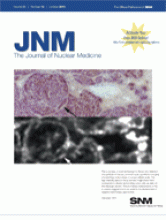REPLY: We would like to thank Dr. Watson for his interest in and comments about our paper (1).
The main concern raised is the rationale behind the choice of noise-equivalent count density (NECD) over noise-equivalent count (NEC). The choice was indeed guided by the logic inherent in equalizing signal-to-noise ratio (SNR) per unit image volume. However, the use of NEC to represent image quality in a clinical PET study is premised on its being a global measure of the data quality obtained in the study. Consequently, we think that NECD represents a reasonable global metric to equalize the general image quality between different-sized patients (children and adults) if the image quality is high enough in large patients. Any effort to measure the effects of disease in specific organs or cancerous neoplasms will be sensitive to local effects in the images (such as spatial resolution, image reconstruction, and data corrections), and so the choice of either NEC or NECD as a surrogate for any form of image quality index should be used with caution, especially given that little supporting evidence is available for either option.
A second concern relates to the use of the Gemini 16 PET/CT scanner (Philips Health Care), as well as the manufacturer's recommended dose regimen that was followed. Our work was performed on only 1 scanner, admittedly no longer state-of-the-art, but the technique (based on Dr. Watson's original work) should be independent of the performance of that scanner. Based on input from our clinical colleagues, images obtained from the Gemini 16 are clinically useful in large patients and, commonly, better in light patients for the same scanning time and weight-based dose regimen. As a result, we believe that using the peak or close to the peak (e.g., 90%) NECD value in adults as a guideline to derive specific regimens for pediatric studies is justified.
- © 2010 by Society of Nuclear Medicine
REFERENCE
- 1.







